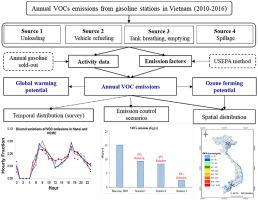Atmospheric Pollution Research ( IF 3.9 ) Pub Date : 2020-03-11 , DOI: 10.1016/j.apr.2020.03.002 Lai Nguyen Huy , Nguyen Thi Kim Oanh

|
Fugitive emissions of toxic volatile organic compounds (VOCs) from fuel distribution systems are largely overlooked in air quality management (AQM) in developing Asia. We estimated annual VOCs emissions, associated ozone-forming potential (OFP) and global warming potential (GWP) from gasoline stations in Vietnam for 2010–2016. Current emission control included submerged filling for underground tanks and no vapor recovery for refueling vehicles. Estimated VOCs emissions in 2016 of 20.9 Gg (54.8 Gg of OFP, 292 Gg of 20-yr GWP) were 1.4 times above those in 2010. Spatially, VOCs emissions had high intensity over large urban areas and large economic regions, with Southeast economic region and Red River Delta shared 30% and 25% of the national emissions, respectively. High OFP intensities found over large urban areas would worsen ozone pollution where VOC-sensitive regime presents. Monthly emissions were higher during summer and winter holidays coinciding with intensive transportation. Hourly emissions showed peaks in morning and afternoon rush hours. Implementation of vapor recovery of USEPA Stage I (underground tank filling) and Stage II (vehicle refueling) control, respectively, would reduce VOCs emissions by 38% and 45%, while simultaneous implementations of both reduce emissions by 83%. Equal reductions would be seen for associated OFP/GWP. Control of VOCs emissions from gasoline stations helps improve air quality by reducing ambient levels of toxic VOCs and secondary pollutants of ozone and fine particles, and gain climate co-benefits through GWP reduction. Prepared spatial and temporal VOCs emissions distributions are useful for local AQM and air quality modeling studies.





















































 京公网安备 11010802027423号
京公网安备 11010802027423号